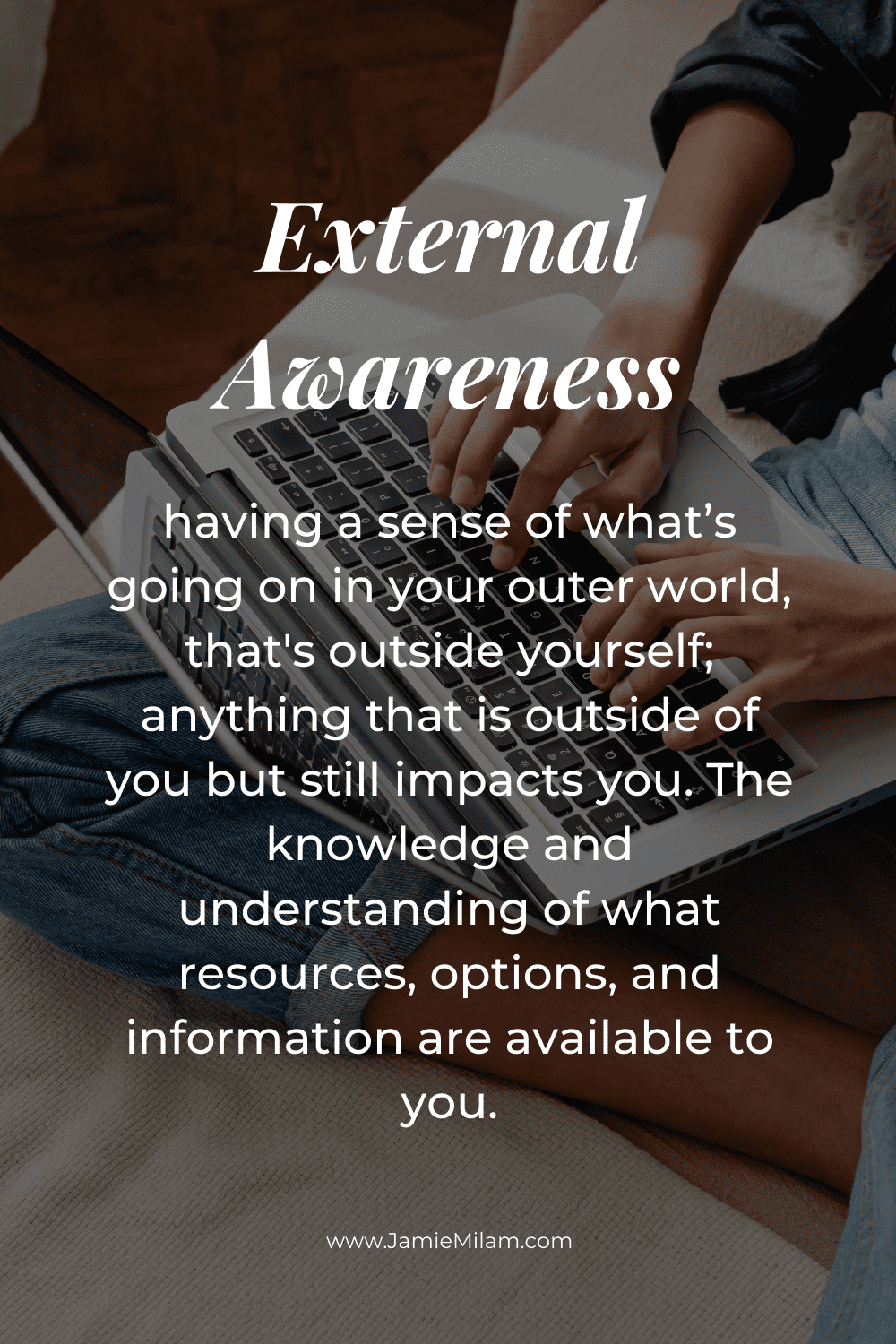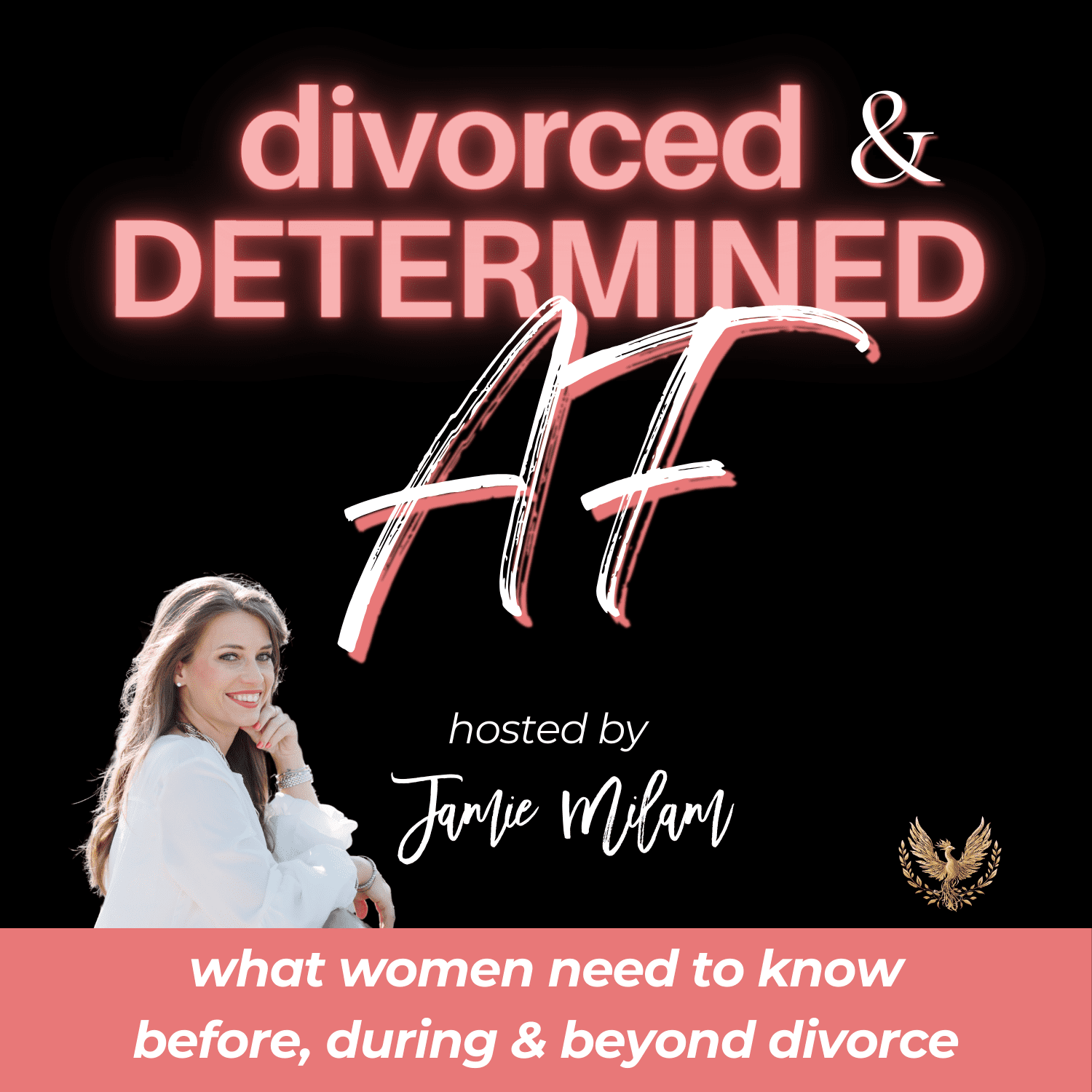THE BLOG
THE BLOG
*This website uses affiliate links which may earn a commission at no additional cost to you. As an Amazon addict and Associate, I earn from qualifying purchases, but I'm only recommending products I love!
Browse More Blog Posts:

Internal and External Awareness:
What They Are and Why You Need Them
Awareness is important to navigate through life.
Just think—to be a safe driver, you need to be vigilant and aware of the other cars on the road. To dress appropriately for the weather, you need to be aware of the temperature outside. Or, going deeper, to build a strong relationship, you need to be aware of how someone else feels and reacts to you.
These are just a few examples, but you get the point—awareness is key to moving through life successfully.
And when it comes to living your best life, your most aligned and purposeful life, you need to know about internal awareness and external awareness. They're important individually and, when used in conjunction, they allow you to make the best decisions and strategic plans to live your best life.
Here we'll cover what both internal and external awareness are and some practices you can use to improve and tap into them in your life.
Internal and External Awareness: What They Are
Understanding internal and external awareness will help you foster them in your life which, in turn, helps you make better decisions for your aligned life. So, let's start with some definitions.
Internal awareness, or your self-awareness, is your connection to your inner world. It's the deep knowledge and understanding you have about your needs, motivations, fears, goals, and values—everything that makes you tick.
Through increased self-awareness, you can not only start to recognize and identify these things, but you can take action on them. For example, say you're working with a therapist to understand why you blow up every time your partner says something specific. You identify some triggers based on past experiences and notice behavior patterns—this is the recognition and identification part. But then, based on this knowledge, you can start to change your behavior and create new, healthier relational patterns—this is the important action that will impact your relationship.
External awareness, then, is making sense of what's going on in your outer world. That is, what's going on around you? What's available to you that's outside yourself. To note, this is not external self-awareness, or the way other people see you, but it's the things that exist outside of you.
Examples include things like education, resources, employment opportunities, new connections, economic factors, your physical environment, and anything else that is outside of you but still impacts you. When you have strong external awareness, you recognize, understand, and act upon these things to create your aligned life.
Practices to Increase Internal and External Awareness
Notice the two parts to increasing awareness: recognizing or identifying and acting. Without the first, you can't do the second. You can't take inspired action in your life without first recognizing and identifying what's going on internally and externally.
Here are some practices that will help you tune into your inner and outer worlds so that, through increased awareness, you can begin to take meaningful actions and make better decisions.
3 Tips to Boost Internal Awareness
You've probably heard that expression, "wherever you go, there you are." Read it again and focus... there you are. You take yourself into every situation and experience in your life so you need to know yourself! Increasing your internal awareness is always important—here are three key practices to increase it.
1. Learn to Notice Your Body's Cues
Your body has deep wisdom. It knows how you're feeling long before you even do. So when you can start to notice your body's cues, you can identify tension, frustration, anxiety, anger, or any other emotion you're holding on to. Then, with this increased self-awareness, you can take steps to emotionally regulate and reset.
One of the best ways to learn your body's cues is through Marie Forleo's exercise (from her book Everything is Figureoutable):
- Get comfortable: I prefer to sit, but you can also stand. Relax, get comfortable, and let your body be at ease. I like to sit with my hands face-up on my thighs. Notice the weight in your chair, your feet flat on the ground. Be present in your body.
- Breathe: Once you’re in a comfortable position, take three deep, full breaths. The kind of breath that you feel throughout your entire body. Take note of how your shoulders rise and fall with each breath. Pay attention to how it feels.
- Ask and listen: Once you’ve centered yourself through deep breathing, ask yourself this question: Does saying yes to this make me feel expansive or contracted?
Your body will react instantly and, perhaps, subtly. Pay attention to the feeling you have in the split moment you ask. Do you feel excitement, openness, or joy? Or is your body tight and heavy with a feeling of dread. This is your body's wisdom telling you what to do. You can dive deeper into this practice on my blog about how to trust your gut.

2. Use Journaling to Process Emotions
The next practice that can really help you increase self-awareness is journaling. Some people seem to love it, but a lot of people are also resistant to journaling. Perhaps it "takes too much time" or you don't know where to start. But getting your thoughts and feelings out of your head and onto paper is transformational to increasing self-awareness.
Luckily, there are tons of different ways to journal. Here are a few ideas to try:
- KISS: You know, "keep it simple, stupid" (or the friendlier version, "keep it super simple"!). Short journal entries are better than none and bullet-point thoughts are totally acceptable. You don't have to make it a big thing — just try to spend time most days writing something down. If I'm short on time in the mornings I always try to at least jot down what I'm grateful for. Try out this free Gratitude Growth Journal to help you create the habit!
- Art journaling: If you love to sketch or paint, include this in your journaling. You can draw pictures or ideas and use colors or patterns to express yourself. You can mix art with language and see what comes to mind when you open up your journal.
- Stream of consciousness: Don't think, just write. Use your journal as a mind dump and get everything out onto the page. You can try the "morning pages" method, made famous by author Julia Cameron in The Artist's Way. In it, Cameron advocates for three pages of longhand writing every morning when you wake up... don't worry about knowing what to say, just start write paper and let it flow!
- Themed journaling: If you find it hard to write your thoughts, feelings, or reflections, you can slowly enter the world of journaling with various themed entries. For example, write about great restaurants you visited or travels you've had. This is a good way to get into the habit of journaling without
3. Create Vision Boards to Know Deep Desires
The last practice I want to highlight is using a vision board to help visualize what we deeply desire. Sometimes our desires are hidden deep and it takes some creativity and intention to bring them to the forefront of your mind.
A vision board is a creative way to do this. You can use any kind of medium you want—digital, posterboard and magazine cutouts, hand-drawing, writing—anything you feel comfortable with.
There's no right or wrong way to do this, but if you're feeling stuck, consider looking on Pinterest for some examples of what other people have done. You can also use these questions to jump-start your reflection:
- What do I envision my life to look like in one, three, five, or ten years?
- Where would I be if there were no limitations on my time, money, or energy?
- What would I be doing if I was completely fearless?
- What energizes me?
- What does success look and feel like?
- What are my core values?
When you identify your authentic needs and desires, which these practices help with, you can start to honor them. Honoring your needs and desires plays out in a few different ways:
- Boundaries: Maintain strong boundaries by saying "no," effectively managing your schedule, choosing who you spend time with, and setting up systems to manage workload. This helps protect your time and energy so you can put it towards what's most important to you.
- Self-care: Both the fun (bubble baths, time with friends, good music) and the less-fun-but-necessary (cooking at home, hitting the gym) are essential self-care practices that support what your mind and body need. When you are in tune with your needs through self-awareness (i.e., "I'm exhausted. I need rest.") you can use self-care practices to support yourself.
- Communication: Increased self-awareness helps you communicate more effectively because you can put words to your internal experience. You can express your needs or desires and you can communicate them to other people. This helps you achieve and work towards the goals you have for yourself.
3 Areas to Increase External Awareness
As we discussed, external awareness is knowing what's going on in your external world—what's available to you that's outside yourself. This is a very broad category and encompasses a lot of different factors.
However, there are three key areas you can focus on to increase your external awareness.
1. Education and Resources
Here's a question to ask yourself: What is available to you to increase knowledge and learn more about the direction you want to go?
Say your self-awareness journey has led you to seek out opportunities in a certain career. You need to then go and pursue further education and resources to make sure you learn what you need to know while on that path. There are so many ways to do this:
- Formal classes or training programs
- Podcasts (Pssst, the first 50 episodes of my podcast was aimed at helping female entrepreneurs back when it was just Determined AF. So go check that out as a free business resource - and of course now it offers lots of resources for divorcing/divorced women!)
- Online communities (i.e., Facebook groups, Reddit, Discord)
- Workshops
- Professional resources
- Conferences
- YouTube

We're lucky to have so many ways to learn and educate ourselves today. But it can be intimidating to jump into something new and put ourselves out there to learn. Remember this—you don't know what you don't know! That's nothing to be ashamed of.
The key here is to take the first step to knowing and jump into a space with curiosity and a genuine desire to learn. Simply asking, "Where do I begin?" is a way to start on the path. You need to forget the fear and ask the questions—do it for you.
2. Opportunities
Your aligned path has to correspond with opportunities that are realistically available. That doesn't mean you don't aim high—you do! But it's also important to be aware of what opportunities are available, or ones you can create, in order to reach your goals.
Fear of the unknown tends to be a huge cause of overwhelm. But you can break that down by starting to identify what options and opportunities exist so you can begin to formulate a plan.
All of the above education or resource spaces are a great way to learn about potential opportunities. You can also:
- Talk to family, friends, or your network about what's available.
- Go on information interviews with people in different industries to learn more.
- Get inspired by what you see on social media or even in movies and TV (just make sure to follow up with thorough research!)
3. Relationships
Colleagues, employees, friends, family, network partners, service providers, collaborators... the list goes on. We all interact with a variety of people each day who impact our lives and may help or hinder where you want to go in life.
It's important to be thoughtful and intentional in your relationships—both with the people you currently know and the people you may meet. We can't dive into a complete guide to building healthy relationships, but here is some food for thought to consider:
- There's power in curiosity: Ask questions and be curious about other people. This can help you connect and empathize with them in a better way. As you get to know someone and where they're coming from, you can understand if they are going to truly support your needs or endeavors in a genuine manner or not.
- Clarity is key: Setting expectations and boundaries are both important when it comes to building effective relationships. Say you're working with a new partner or service provider, take time to set very clear expectations from the beginning so that you can identify the right people you want to work with—the people who are aligned with you and able to meet those expectations. Boundaries work the same way—they show you who wants to work with you and be on your team. If they don't respect your boundaries, they aren't the people to align with for future endeavors.
This is not an exhaustive list of everything that makes up internal and external awareness, but helps illustrate the differences.
The key, though, is using them in conjunction to make decisions and craft strategic, aligned plans. Let's illustrate how they work together with an example:
You've been feeling "stuck" at work for a long time and know something has to change. But what? You start working with a coach or therapist who helps you get in touch with your authentic needs and desires. On your self-awareness journey, you learn that you're triggered by the micro-managing demands of your boss and want to move into a self-directed career. So you start exploring some options in real estate by attending local lunch-and-learns with other professionals in your area. You're connected with people who can point you in the right direction for where to gather more information and start a new career.
- Internal awareness = awareness that something needed to change, working with a professional for more clarity, and taking aligned action steps.
- External awareness = seeking out new information and forming relationships to foster a career change.
Even if you start implementing these tips and practices, awareness might not turn "on" like a light switch. Instead, think of it more as a dimmer dial—you slowly turn the dial and the lights in the room get brighter. It's a gradual—but noticeable—process over time.
The more you practice, the easier this all becomes. Awareness will come more naturally and, eventually, your intuition and gut feelings will become your guiding compass to let you know which opportunities or partnerships are right or wrong for you.
My entire mission is to help women who seek more awareness, clarity, and alignment in their lives. Whether that is on a personal level, a business level, with your real estate needs, or the divorce process - it all requires a degree of awareness to create true alignment, which ultimately helps you feel more at peace with the season you're in. If you desire some guidance into mastering the practice of self-awareness, be sure to download my signature guide, Self-Awareness Mastery: Your Most Powerful Tool!
To becoming more aware,

Save this post to come back to or share with a friend!

About Me
I'm Jamie Milam, a determined AF woman who's embraced life after divorce by finding peace through self-awareness, intentional decision-making, and thrilling new travel adventures.
As a Realtor® in Charlotte, NC (and your connection to top agents nationwide), I’m passionate about guiding you through your homeownership and design goals—while also helping you create space for the things you love. My mission is to empower you to create a life of alignment too - at home, abroad, and within.
Whether it’s through real estate tips, home design inspiration, or solo travel experiences for divorced, independent women, I hope this space encourages you to discover deeper self-awareness and build a life that aligns with your passions and needs.
Have you scoped the podcast series that empowers women to make aligned decisions in a divorce?

Your Free Charlotte City Guide

Jamie Milam is a Realtor® in the Charlotte, NC area, licensed in both NC & SC, and has the ability to refer you to a number of agent partners across the nation, regardless of where you may live. She is an enthusiast for the power of awareness and believes it can be used in all facets of life to support aligned living.
**Disclosure** This post may contain affiliate links and they are at no additional cost to you, though I may earn a small commission. Don't worry, I only recommend products or services that I have tried or believe would be of great value to you! All opinions expressed are those of my own!
Recent Posts
There's More ▾
There's More ▾
Let me share the goods!
Come from contribution, that's a motto I've valued for years! So... that's exactly what I am to provide you, straight into your inbox each week! No fluff and all open-book. Inspiring you to practice awareness, value your authentic self, and implement strategic actions so you can create alignment in your world to live the life you desire and deserve!









